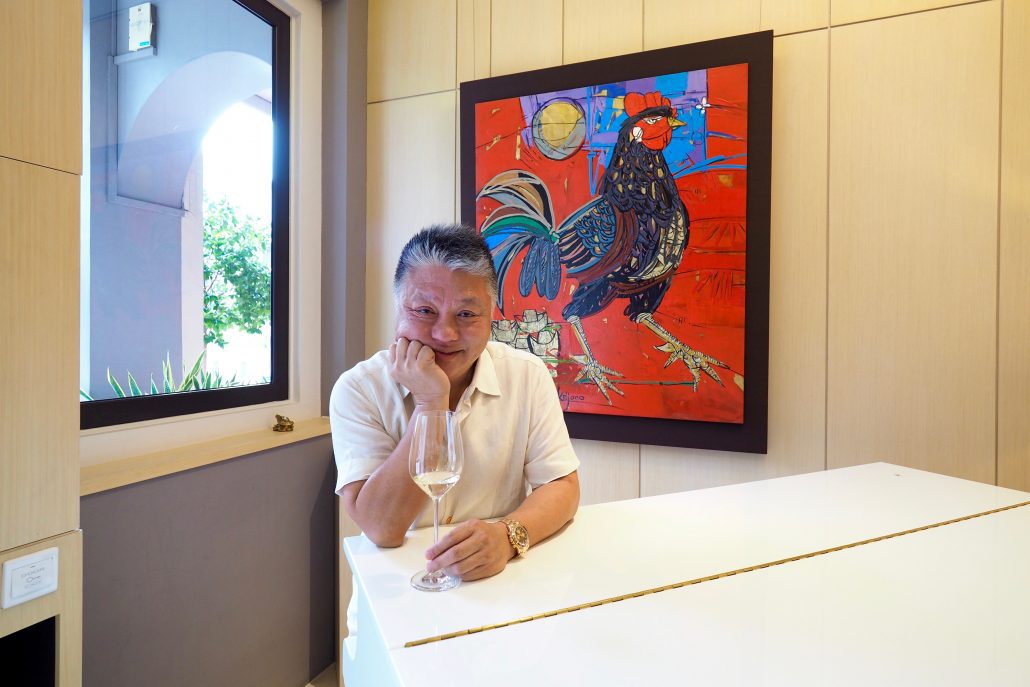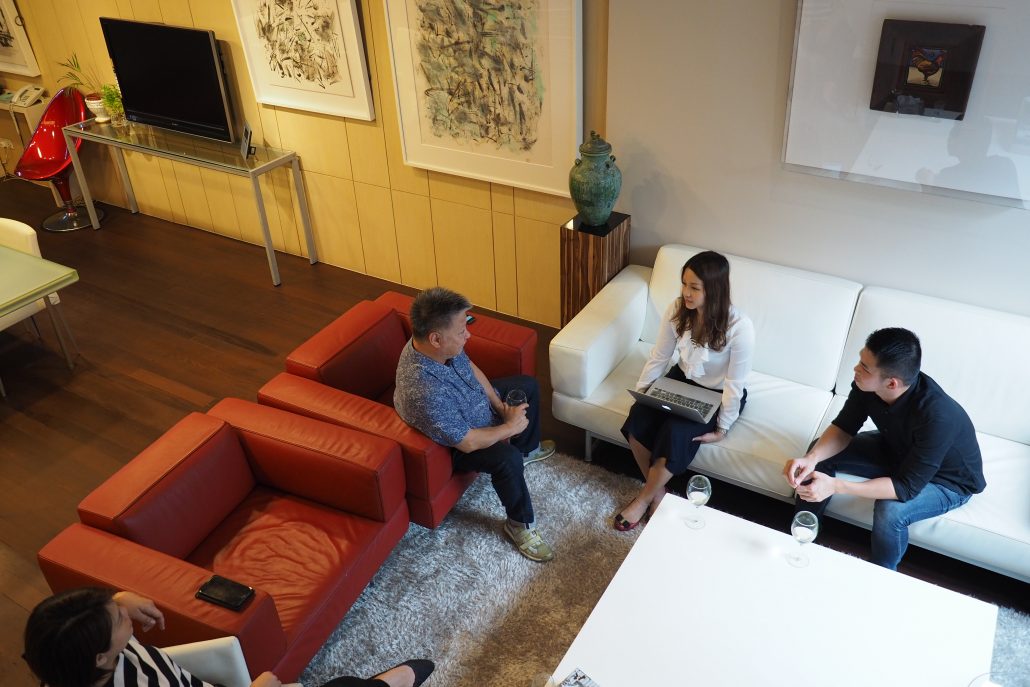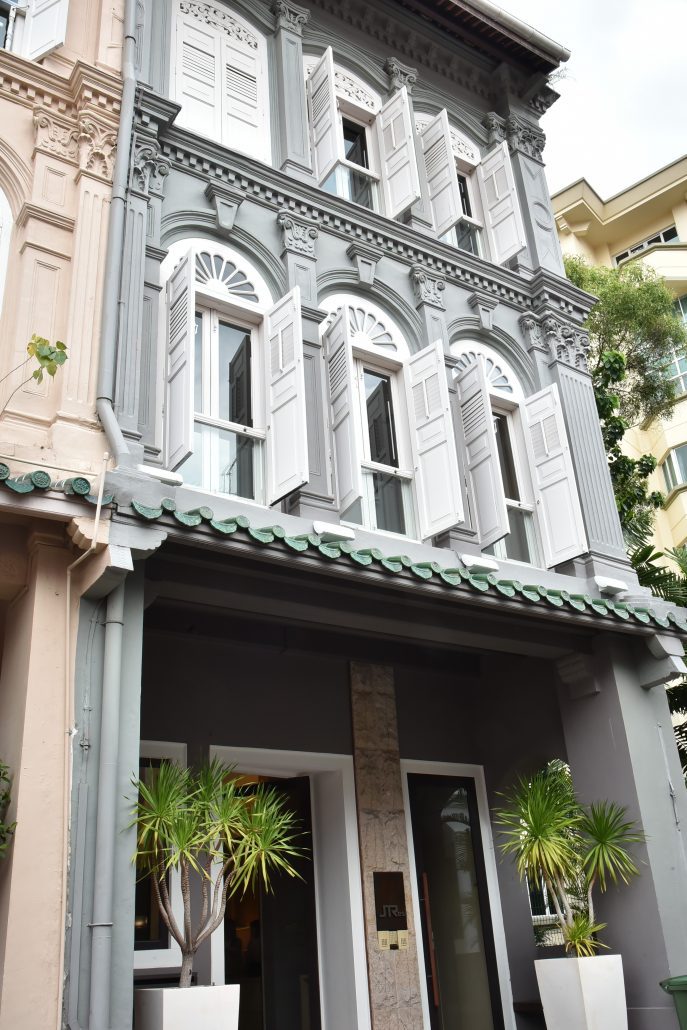
The approach to purchasing a property is different when you’re there; the focus is no longer on the purchase solely being a business transaction. Instead, you’re treated to wine and dine within the premises, and it’s no doubt a glimpse to the life you’d be living after making a purchase.
After 10 years of operations here in 65 Club Street, Jerry is now looking to relocate – not too far away, thankfully. He is a proud owner of one of the 16 waterfront bungalows at Emerald Bay in Puteri Harbour, Malaysia, and hopes to settle in fully by mid-2018.
The team has definitely come a long way – from its humble beginnings right in the aftermath of September 11 to where it is today, these past 16 years have been nothing short of exhilarating. As Jerry relayed to us some of the major milestones he has been through, it is indisputable that you can feel the immense passion he has for the real estate industry; one that he has helped shape over the years.
These stories that were shared with us are living proof of his expertise, and all in all, it was a wonderful afternoon spent with Jerry.
The Redbrick Team (RB): When did your career in the real estate industry start?
Jerry Tan (JT): I started selling properties at the age of 17. This was back in 1976-1977, and my family had a pretty formidable agency business, and that was how I learnt. Right from the ground up. My corporate years were only from 1990-2001, with Colliers, running their residential international and local marketing team. In October 2001 I started JTResi, just after September 11.
RB: How did you feel when that happened?
JT: I resigned on 4th September 2001, and one week later the attacks happened. I thought to myself, ‘what did I do?’
From a very comfortable position, still my own domain, and my ex-bosses were nice enough to call me back, but I said no. I’ve got too much pride for that; once I leave, I cannot come back, no matter how tempting it was deep inside.
True enough, when one door closes, another opens. About 2 weeks later. the Singapore government lifted all the anti-speculation measures that was introduced in May 1996. One of which was allowing foreigners to once again borrow in Singapore Dollars for residential real estate financing.
I took that as an angle and headed south to Indonesia, to re-educate them to come back to leverage, rather than just pay cash. Back then, Indonesians were regarded very high risk because of the Asian financial crisis in 1997-1998. A lot of them defaulted on residential loans and the banks were not really in favour of lending to that market. Fortunately for me, there was 1 bank – HSBC, and they came down with me to support my endeavour, and we really hit big time.
For a good decade, we creamed that market. It was a fantastic run; I just can’t describe it. It was euphoric, because people in Singapore weren’t buying, but we were having a field day, selling in Indonesia and Hong Kong. That was the whole irony of it, and it was just from something that started small. Maybe we were just lucky that technology wasn’t all that wonderful, not so advanced at that time. We were able to control a lot of the prime projects here from the major developers.
Only after we’ve sold what we want to sell, then they’d come back to Singapore to launch it. by then, most of the projects were already half sold, ¾ sold, and opened up back in Singapore at higher prices. Unlike what’s happening today, you buy now and then prices get lower… it’s not good. Our clients in those days believed us. Whenever we had a project, there was a following. People who came in, they bought and then they were able to flip, and they could buy again. In those days, there was no capital gains tax – that was the other thing that was lifted as part of the anti-speculation measures, all that was done away with.
RB: Tell us about your real estate career – what are some of the milestones and major projects you worked on?
JT: My first show in Jakarta with HSBC was The Edge on Cairnhill. It couldn’t even sell 1 in Singapore; the developer tried. We took it to Jakarta, and sold $15M on one weekend. and these were all the big flats – they’re about 3,000 sqft. This was in November 2001.
We were so poor we couldn’t even afford a nice ad, so I rented a small space in the World Trade Centre there called Mercantile Club. And I ran an advertisement, one ad only, that showed a picture of The Edge, and another project on Nassim road – 9 Nassim. I got both developers to sponsor one ad, and it said “by appointment only, on the weekend”. Just one ad in Kompas [local newspaper], it said, “come and be re-educated about this lifting of policies”. Because it’s hot news, the phone rang non-stop, both Saturday and Sunday, and I was alone. Jason’s child was just born, so I had to go with a lawyer, a banker, and one-on-one, meeting all these people back to back, each slot between 30 to 45 minutes per person.
There was one man who, until today is a good friend and client, who insisted on being the first on a Saturday morning at 11am. He said, “I want to meet Pak Jerry, first thing in the morning at 11am”. He came, half an hour later, he bought. He paid $4M on this apartment, and I was shocked. He already had one in Aspen Heights, that he sold and he lost money, so he wanted something classier for his own use. Till today, he’s a good friend and client, and my partner did the interior design for his flat.
We also did other projects, such as The Arris on Yan Kit Road; but more importantly, on prime district 9, we did The Imperial, Botanic on Lloyd, Urbana. For all these projects, we would have sold more than half. At that time, a place River Valley was only selling at $800 – $900 psf. In fact, Botanic on Lloyd was only at $750 psf.
Then progressing to Paterson, we did The Paterson. Out of 88 units we sold 44. We also did Paterson Suites, Paterson Residence… Going down towards Holland, we did Trizon because I liked the penthouse so we bought one. We also did Waterfall Gardens, and The Grange. For The Grange, out of 95 units, we sold 85.
Then we did The Tate Residences, out of 85 we sold 44. And then of course, The Marq. We set the record prices, and then they were able to sell higher. But we did it at $5,100 psf for the big one, 6,200 sqft. At TOP, I did another one at $5,800psf, a 3,000sqft unit.
There was also Goodwood Residences, I think we sold about 27 units there. This was before it was even launched in Singapore. We also did TwentyOne Anguilla Park, because the developer knew we did The Marq, so we were helping them in a non-official capacity.
One thing I tell my clients: the first thing any developer does when they appoint an agent here today – they’ll ask you, “how many units?”. To me, I made it a rule – when you talk to me, don’t ask me how many units. Because I’ll tell you zero.
I will do my best, I’ll put my best foot forward, but I cannot promise you numbers. So, on that basis, they pay for everything; flight, accommodation, advertisements, any form of marketing. All paid for by the developer. We just put in our time, but we can feel the market.
There was once when I was in Colliers, in 1994 or 1995, Frasers Centrepoint had this project called The Anchorage. I had to appear before the board, and at that point of time, Medan just had a brutal riot. A lot of Chinese were killed, and Frasers had large flats at The Anchorage, from 1,800 sqft and up. The bigger ones got stuck, but I told my boss that we should go to Indonesia.
They were not sure about Medan, and even asked me “what makes you think that you could sell this in Medan?” I said, “I’m not talking about Medan, I’m talking about Jakarta. There will be capital flight, I know it. So, we will go to Jakarta, and the after effects will come, and we want to be in the centre of it and that’s in Jakarta”. And so, for 3 days and 3 nights, from Friday to Sunday, we sold 100 units.
RB: What is the luxury property market like today?
JT: I think the saddest thing is that prime sites are really not quite there. There isn’t much available to talk about. In some ways that’s why I get a bit disillusioned with the high-end market here. We’re only talking about unsold stock.
But when you talk about exciting sites, sizeable sites… The last one we did was at Goodwood Residences and I really enjoyed that because I truly loved the product, and I can’t see that happening again in Singapore.
From that standpoint, I think that good, unsold stock will still command a premium, but if developers are under pressure, then it’s a different thing. But if developers are not under pressure, then I don’t think they should even be considering… Few developers can actually hold prices because they choose to. That’s to support the buyers that have supported them; and then you have the others that are just cutting away and just trying to dispose of it.
You also see a lot of these en bloc activities, but these sites are all very small. There’s nothing wonderful to talk about. They are all like 50,000, maybe less than 100,000 sqft.
What can you do? You can only build it upwards. You can’t create. In that sense, that’s why you see that certain projects command certain prices that have stuck at a certain level. That means, sellers there are not pressured to put these units back in the resale market. They want their price, otherwise no point selling.
RB: What would you say are the demographics like for the luxury property market?
JT: I think for now, you might see the younger scions of the wealthy families. They’re all coming out to buy now. You can see them; they’re all floating around in the market. Their parents are probably in a GCB right across the street from a condominium, so they want their kids to be near but not too near. At the same time the kids also don’t want to be too near their parents, so they all have their own home, but within proximity. I think there’s a stronger local market buying, more than foreigners, and majority for their own stay.
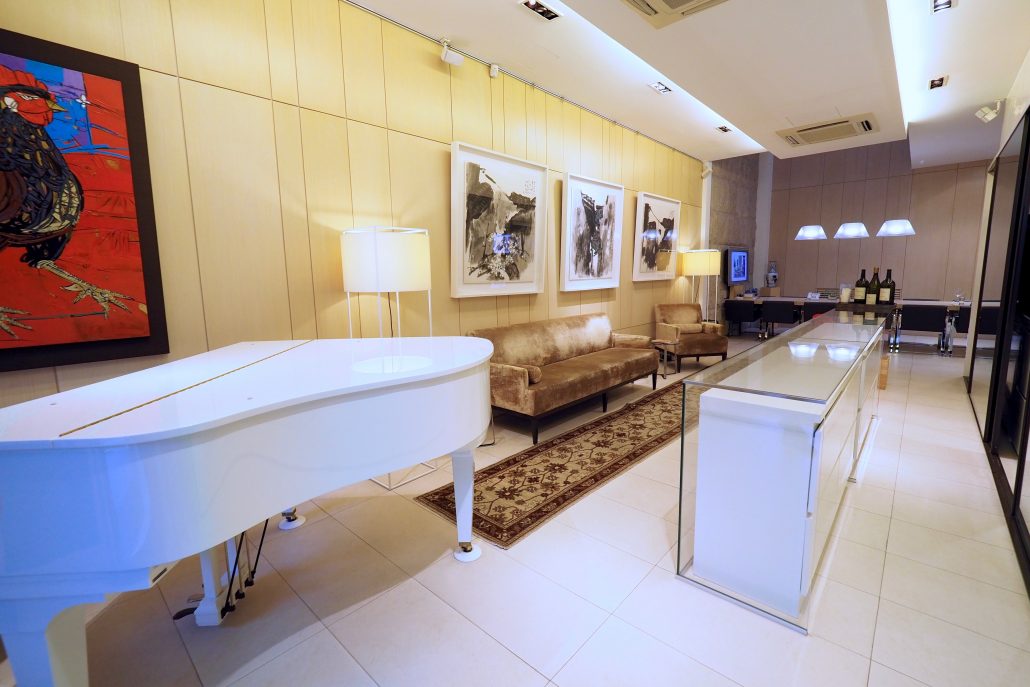
RB: Are districts 9, 10 and 11 still prime locations for luxury properties?
JT: I think 9 and 10 are still considered. I have certain boundaries; I’d only consider 10 not beyond Farrer road, and 9 is basically the Paterson, the Ardmore, perhaps you know Balmoral. Not even beyond Equatorial.
Certainly 11… with all the building activity there it’s terribly congested. It’s prime, but not so prime because it’s all so congested. look at the newton area now – if I had money, I wouldn’t buy the newton area. You can choose your boundaries, where you want to be. Of course, you cut your coat according to your cloth, so it depends on where your budget puts you.
RB: How would they compare to locations such as sentosa cove?
JT: That’s a very tricky question. For Sentosa Cove, it’s only if you are one of the early buyers of that market, and only on landed properties, then you’re okay. But look at the amount of losses that people have experienced there on the condominiums.
It is ridiculous. So, what does it show you? It proves that that market was totally inflated. Because they put the spin that foreigners can buy, that was what pushed it all up. So, it’s a tricky market, but I’ve stuck to my guns about traditional prime freehold. I’m a firm believer of that.
RB: What do buyers of luxury properties usually look out for?
JT: Certainly, it’s location first. But more importantly, I think developers should pay attention to the needs and wants. Many a times it’s a mass production. I follow the belief that less is more, and because the people now that are buying – the discerning buyers – they want space, location, top of the range finishes.
Let me give you an example. The developer of Waterfall Gardens came to us many years ago. Back then, it was a project where the developer had just secured the site. They called us for opinion, and the original idea was to build all 2 bedrooms.
During that time, there was no such demand for large flats because something else next door was just launched not too long ago – called The Levelz, and it sold well. The belief was to go small. But when I saw it, and I explained to the developer that I think this is something that you can be different. So we sat in, and I gave my wish list.
I told them “I only want big flats. 3-bedrooms, 4-bedrooms, and we make it exclusive. Private lift. Domestic helper’s room, not bomb shelter. If you have to put in a bomb shelter, that will be separate.” So, I had my wish list, and they came up with the drawings. In the end, they said to me, “are you sure you can sell this?”
It was a challenge to me. Out of a total of 132 units in 3 blocks, only 3 and 4 bedrooms. There was only a sales gallery, but I took it on tour. We had ground floor units that were large – 2,500 sqft; we had sub-penthouses that were about 4,000 sqft, and even larger penthouses, but the average size was 1,800 sqft and 2,200 sqft.
Out of that 132 units, we sold 122 apartments. The other 10 were basically bought by the directors of the company. There was no launch in Singapore, and it was mostly bought in Hong Kong and in Indonesia. It was one of the most memorable projects because I was right in terms of what needed to fill that vacuum in that area.
You have all the good class bungalows not far away in that area. So, when units started flipping in Singapore, some of the GCB buyers started asking, “how come this project never came on the market?” These were GCB owners who wanted to buy for the children, or their children who were living with their parents and wanted to buy, asking why this project wasn’t in the market. By the time they got to know of it, nothing left.
The price climbed all the way up to about $1,700 – $1,800 psf. It started from as low as $1,100 – $1,200 for the larger flats. People were flipping and Singaporeans started buying the flips. It was quite amazing. But the product was important. They could have built more, but in the end, we only got 132 units in 3 blocks.
This was way before D’leedon, Leedon residences, etc. – this was the anchor there. In fact, the rental price today is still good. A 4-bedroom unit there, 2,196 sqft, still transacts at about $8,900/month.
So, that was really fun, but thank goodness, the developer wanted our opinion. And when I changed the whole concept from small to big, they were quite intimidated. But when we did it… shiok. Of course, the commission was amazing! (laughs) Not many agents can claim that you sold a high-end development and you got a bulk of the fee.
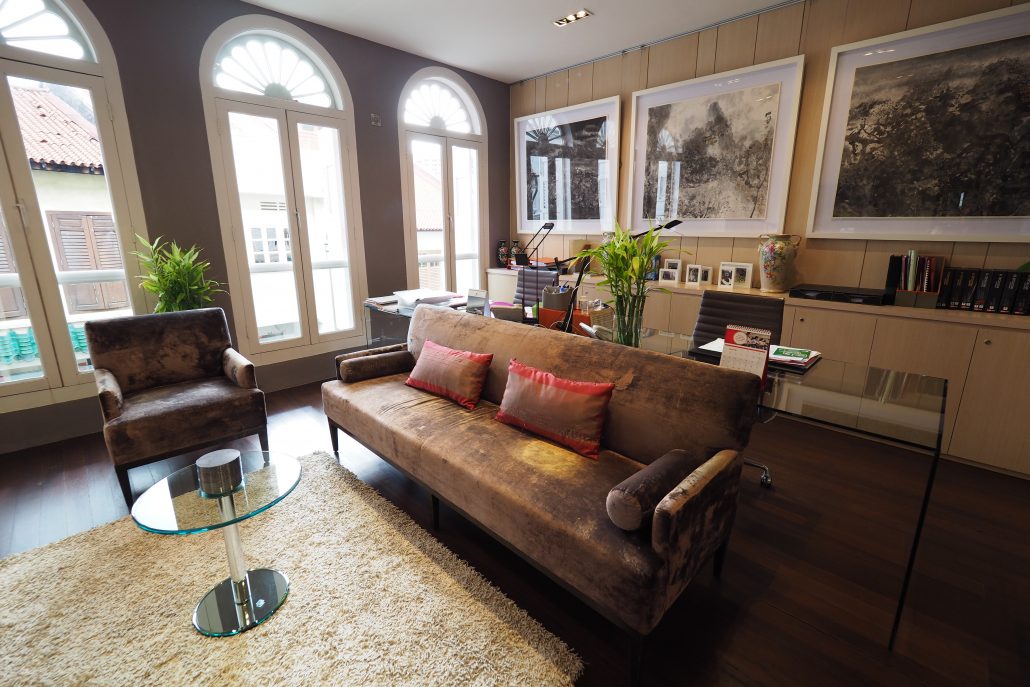
RB: What about the luxury property market in Malaysia? What do you think about it?
JT: I’m so glad you asked. You’ve hit a topic I’m very passionate about.
I’m moving to Malaysia, not just Malaysia. I’m moving to Puteri Harbour – Emerald Bay. Let me just give you the premise – I would have never been interested in putting a single cent in Malaysia.
Not Penang, not KL, not Johor, not Melaka, not anywhere in Malaysia, period. But in 2012, I was introduced to this project called Emerald Bay. The person that introduced it to me worked for the developer, and he was my ex-staff in Colliers.
He had gone back to Malaysia, got married and had kids, and he worked for this particular developer (BRDB). I happened to know this developer, because he’s actually a Singaporean.
So, I had a call when I was on holiday in Sydney. And he said, “boss – he still calls me boss – you must come and see this project”. I said, “in Malaysia? You’ve got to be kidding me.” Then he said “no, you’ve really got to see this.”
So, he came all the way here to present to me, and then I thought it looked quite interesting. I said I want to take a trip there, so we organised one. There was nothing to see; this is exactly sentosa cove with the water ways and all that going to the ocean. And when I looked at it, it was also believing that the developer will actually do up the infrastructure, since none of the infrastructure was done up then.
Today if I were to take you there and show it to you, the first phase of it has been completed. All the infrastructures on the waterways have been done. The developer is just taking his time to build the rest of the houses. But the first 100 homes have already been built, and of course I bought one of the 16 waterfront houses, with a private mooring and all that.
To me, that is class. That is something I will put my money on, because that’s where I’m going to live. I’m not crazy to just go for the sake of going, but this is an exceptional product.
The tricky part was there there’s too much, too soon in Malaysia. From Penang, to KL, to Iskandar. To me, I would never put my money on the JB city side. This is just me, but infrastructure is old there. They’re now trying to rejuvenate it, but who knows how long it’ll take?
On the other part of Iskandar where Puteri Harbour is, Medini and all that, it’s all new. New infrastructure. Having said that, even when you come in and you see Medini and all that, it’s quite frightening.
But once you get to where emerald bay is, you can straightaway identify – it’s a whole different ball game. Yes, it’ll probably take another 5 years before it fully matures, but I intend to live there, I intend to help the developer market it, and have fun.
It’s knowing where to put your money. freehold, landed, emerald bay. It’s the way to go.
I hope to be fully living in it by middle of next year, and then commute to Singapore for work. I think it’s fabulous, and it’s a fraction of the price. At the time we bought it in 2012, there was nothing to see – RM$6.08M. Everybody told me, “you’re mad for putting that kind of money there.” And the beautiful part of it is that you can get funding. The banks are very conservative about lending on projects, but with Emerald Bay, there is no problem in getting funding.
RB: What do you think the Malaysian property market will be like?
JT: I think it’s going to be very long drawn. If you bought thinking you could make money, forget it. If you’ve bought, make sure you use it. Because I don’t think even rental can work.
But where we are, I’ve already seen the first inflow of expats. you know why? because of the schools. Marlborough College. Raffles American school. In my estate now, the first expat family has already moved in, and they are Brazilian. they’re paying RM$8,000/month for a terrace house. On the bungalow stretch, most of them are owner-occupied, and owners are mostly Malaysians.
To answer your question – I think Malaysian properties are very tricky. You can end up owning a lemon because you think it’s cheap. It’s actually not cheap. When I committed to buy Emerald Bay, the exchange rate was 2.5 – 2.6 [to S$1]. Then I was wondering if we should borrow? But I was so amazed, because I thought by borrowing, you hedge. And now look, the MYR to SGD ratio is 3.1! That’s a lot of savings, so it’s better to borrow, if the bank is willing to lend you.
One thing about Malaysia and their policies – anything can change, anytime. But we cannot ignore Johor as our backdoor. It’s going to be an extended suburb. I’m amazed at the number of Singaporeans who are actually living where we are living, in the older estates. They are either renting or they bought because their children are going to school there.
–
Today, JTResi is no longer about exhibitions. The company is focusing on taking care of its loyal group of clients, managing their properties, and the referrals that come from their network. Specifically, people who seek advisory on what to buy or what not to buy.
For certain projects that are still interesting, the team will still handle it, provided they have some control over it.
Jerry Tan only sells what he likes. It has to be something he has to appreciate.
Want to find the best mortgage rate in town? Check out our free comparison service to learn more!
Read more of our posts below!


